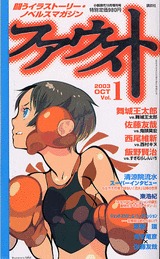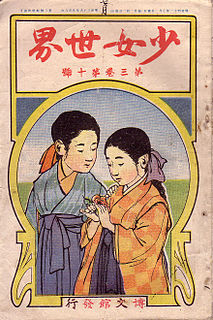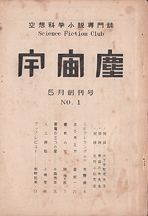 W
WAkai tori was a Japanese children's literary magazine published between 1918 and 1936 in Tokyo, Japan. The magazine has a significant role in establishing dowa and doyo, which refer to new versions of children's fiction, poetry, and songs. In addition, it was pioneer of literary movements, doshinshugi and jidō bungaku.
 W
WFaust is a literary magazine published irregularly by Kodansha since 2003 promoted as a "Fighting illustory magazine." Square-bound like novels, all volumes have remained in print. Faust features young writers and a style derived from light novels. The magazine is single-handedly edited by Katsushi Ōta, who was also in charge of the Kodansha Box line.
 W
WFujin Kōron (婦人公論) is a Japanese bi-weekly women's magazine published by Chūōkōron-Shinsha. It was founded under the concept of women's liberation and establishment of selfhood. It was first published in January 1916. It is one of the new intellectual feminist magazines in Japan during the 1910s.
 W
WGunzō (群像) is a Japanese monthly literary magazine published in Japan.
 W
WKyoto Journal is a quarterly magazine based in Kyoto, Japan. Its subtitle, Perspectives from Asia, reflects its commitment to "local voices, from all over Asia" and "ideas that illuminate cultural differences in a positive way, that promote intercultural understanding via specifics, not generalities." In addition to its four main editors, the magazine is staffed by a team of interns and over 30 contributing editors spread throughout Asia. Its diverse readership and list of contributors has been described by former editor Stewart Wachs as a "psychographic" community. Since its founding, the magazine has been entirely produced by volunteers.
 W
WMita Bungaku (三田文学) is a Japanese literary magazine established in 1910 at Keio University that published early works by young Japanese authors such as Yōjirō Ishizaka, Kyōka Izumi, Hakushū Kitahara, Jun'ichirō Tanizaki, Takitarō Minakami, Kojima Masajirō, Ryūnosuke Akutagawa, and Ayako Sono.
 W
WMyōjō was a monthly literary magazine published in Japan between April 1900 and November 1908. The name Myōjō can be translated as either Bright Star or Morning Star.
 W
WThe Nyonin Geijutsu (女人芸術), which translates to Women's Arts, was a Japanese women's literary magazine that ran from July 1928 to June 1932. It was published by Hasegawa Shigure. They published 48 issues that focused on feminism and women's art and literature. It was one of the most influential Japanese literary women's magazines since the Bluestocking.
 W
WPoetry Kanto (ポエトリ関東) is a Japan-based, English and Japanese bilingual poetry print journal founded and originally edited by award-winning translator William I. Elliott and internationally acclaimed poet Shuntarō Tanikawa. The annual journal, currently edited by Alan Botsford, is published by the Kanto Poetry Center at Kanto Gakuin University in Yokohama, Japan and showcases modern and contemporary Japanese poetry in English translation, as well as contemporary English-language poetry from the United States, the United Kingdom, New Zealand, Australia, Wales, South Africa, Hong Kong, Canada, Ireland, and other countries. Bridging East and West, Poetry Kanto features "outstanding poetry that navigates the divide of ocean and language from around the world."
 W
WSenki was a Japanese proletarian literary magazine in the late 1920s and early 1930s.
 W
WShōjo Sekai was one of the first shōjo magazines in Japan. It was published by Hakubunkan beginning in 1906 and was initially edited by renowned children's author Sueo Iwaya , better known by the pen name Sazanami Iwaya . Shōjo Sekai was created as a sister magazine to Shōnen Sekai , which was also edited by Iwaya, and which began publication in 1895.
 W
WSubaru (スバル) was a literary magazine published monthly in Japan between January 1909 and December 1913. The name of the publisher was Subaru (昴), written in kanji as opposed to the magazine title written in katakana.
 W
WTaiyō was a Japanese literary and general interest magazine that existed between 1895 and 1928 which covered the Meiji and Taishō eras. The magazine was published in Tokyo, Japan. It is a significant publication which contained mostly literary criticism, samples of Japanese literature and translations of the literary work by international authors. The magazine was one of the publications of Hakubunkan that made it well-known in the country.
 W
WUchūjin (宇宙塵) was a Japanese science fiction fanzine published from 1957 until its 204th issue in 2013. It was Japan's first science fiction fanzine. It was awarded a special Seiun Award in 1982 as Japan's oldest science fiction fanzine, and received an honorable mention for Best Amateur Magazine at the 1962 Hugo Awards.
 W
WWaseda University , abbreviated as Sōdai (早大), is a private research university in Shinjuku, Tokyo. Founded in 1882 as the Tōkyō Senmon Gakkō by Ōkuma Shigenobu, the school was formally renamed Waseda University in 1902.